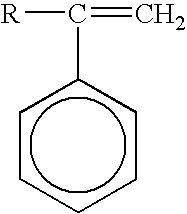Superabsorbent polymers and method of manufacturing the same
a superabsorbent polymer and surface crosslinked technology, applied in the direction of bandages, chemistry apparatus and processes, other chemical processes, etc., can solve the problems of increasing the cost of sap manufacturing, and reducing the efficiency of sap manufacturing
- Summary
- Abstract
- Description
- Claims
- Application Information
AI Technical Summary
Benefits of technology
Problems solved by technology
Method used
Image
Examples
example 1
[0088] In general, PM can be prepared from an aqueous solution containing about 10% to about 40%, preferably about 15% to about 35%, by weight, acrylic acid, more preferably about 20% to about 30%, and most preferably about 25% to about 28% by weight, with an appropriate amount of internal crosslinking monomer. A PAA so obtained is neutralized with sodium carbonate, potassium carbonate, ammonium carbonate, sodium hydroxide, or a mixture thereof, to DN=60-95.
[0089] In particular, a solution containing 25% by weight acrylic acid, 0.07 mole percent methylenebisacrylamide, appropriate levels of initiators (2,2′-azobis(2-amidinopropane) dihydrochloride and sodium persulfate), at an initiator temperature of 18° C., yielded a hydrogel that, when neutralized with sodium carbonate powder to DN=75 percent and then dried, milled, sized, and post-modified by surface crosslinking, yielded a PAA with an average gel volume of 41.2 gm / gm, an absorption under load (AUL) of 34.1 gm / gm (0.28 psi load...
example 2
[0125] A solution containing 1% to 5%, by weight, of PRIMID™ XL-552 and 0% to 37.5%, by weight, propylene glycol in water was applied to the surface of SAP particles, at the rate of about 4 to about 10 grams of solution per 100 grams of SAP particles. The surface-treated SAP particles then were heat treated at about 150° C. to about 170° C. for about 60 to about 120 minutes. Excellent results were achieved using a 3.5% PRIMID™ XL-552 / 25% propylene glycol solution applied at about 7 grams of solution per 100 grams of SAP particles, then heat treating for about 120 minutes at 160° C.
Clay
[0126] A clay useful in the present surface crosslinked SAP particles can be a swelling or a nonswelling clay. Swelling clays have the ability to absorb water and are swellable, layered organic materials. Suitable swelling clays include, but are not limited to, montmorillonite, saponite, nontronite, laponite, beidelite, hectorite, sauconite, stevensite, vermiculite, volkonskoite, magadite, medmontite...
example 3
[0141] In this example, SAP particles, including SAP fines, were surface crosslinked in the presence of a kaolin clay slurry. In particular, unsifted PAA (DN=73) (1000 grams) in a Lodige Model M5B coater machine was sprayed with a mixture containing water (21 grams), propylene glycol (21 grams), a kaolin clay slurry (286 grams, 70% active), and ethylene glycol diglycidyl ether (2 grams).
[0142] The surface treated SAP particles contained 20% boaa (based on weight of acrylic acid) kaolin clay, and 0.2% boaa ethylene glycol diglycidyl ether. The coating machine is configured with a jacket for heating the surface treated SAP particles. Coating time was about one minute. The temperature of both the SAP particles and the mixture was 25° C. After complete addition of the mixture, the surface treated SAP particles were heated to 120° C. over a 30-minute period. After reaching 120° C., the surface treated SAP particles were heated for one additional hour to effect surface crosslinking. The ...
PUM
| Property | Measurement | Unit |
|---|---|---|
| Fraction | aaaaa | aaaaa |
| Fraction | aaaaa | aaaaa |
| Fraction | aaaaa | aaaaa |
Abstract
Description
Claims
Application Information
 Login to View More
Login to View More - R&D
- Intellectual Property
- Life Sciences
- Materials
- Tech Scout
- Unparalleled Data Quality
- Higher Quality Content
- 60% Fewer Hallucinations
Browse by: Latest US Patents, China's latest patents, Technical Efficacy Thesaurus, Application Domain, Technology Topic, Popular Technical Reports.
© 2025 PatSnap. All rights reserved.Legal|Privacy policy|Modern Slavery Act Transparency Statement|Sitemap|About US| Contact US: help@patsnap.com



